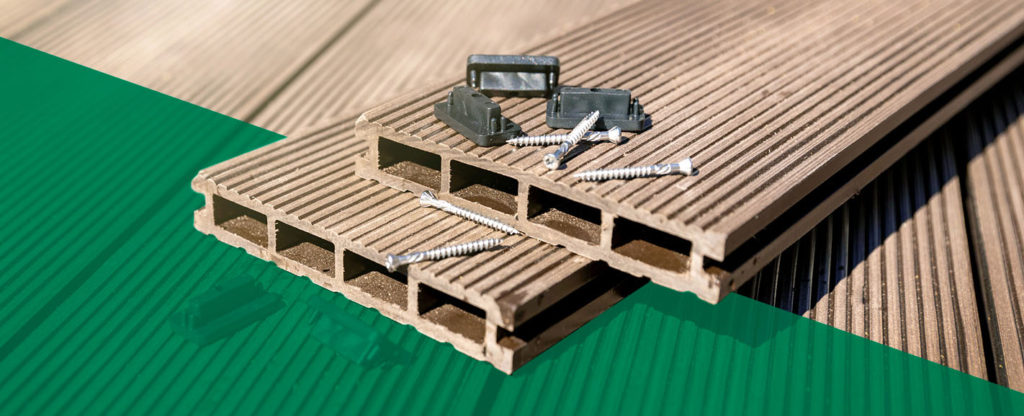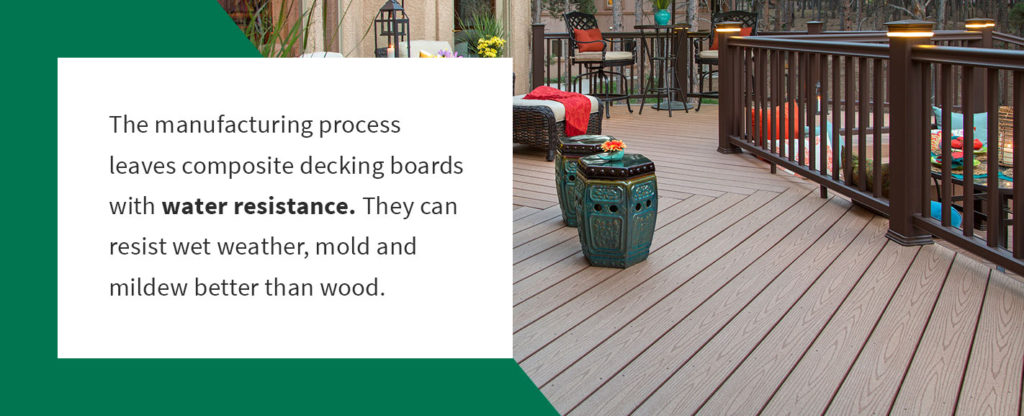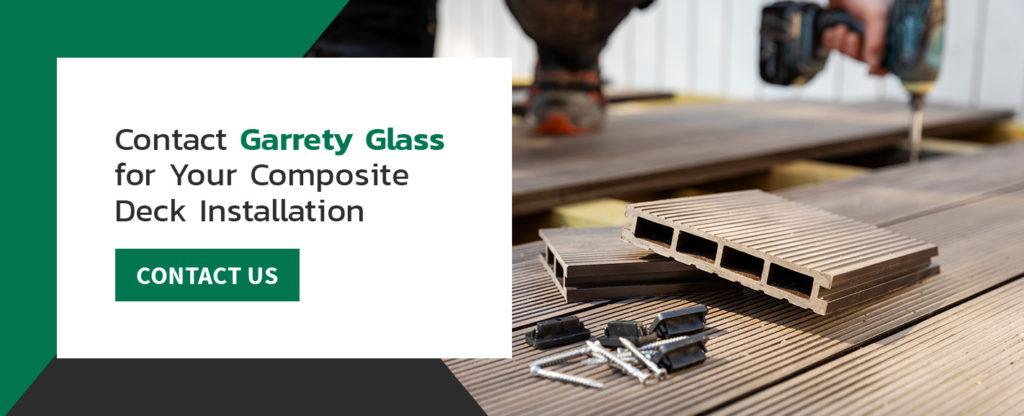
When you’re building a new deck or replacing an older one, there are many factors to consider. One of the most important is what materials to use for your deck’s surface. While most people think of traditional wood, wood composite is also available. This guide will review what composite decking is, the types of composite decking, its advantages and disadvantages and some of the most frequently asked questions about it.
What Is a Composite Deck?
Composite decking material is composed of wood fibers and plastic, making it stronger and denser than wood. As an environmentally-friendly wood alternative, it boasts lower maintenance requirements, greater durability and a longer life span. Additionally, manufacturers can create composite wood decking that replicates the look of exotic and domestic hardwoods.
Types of Composite Decking Boards
The three types of composite decking boards are solid, hollow and capped:
1. Solid
These composite boards are heavy, strong and durable. They more closely resemble wood and are common as swimming pool decks, pathways to homes and permanent flooring in hotels, homes and offices. However, solid composite decking boards might expand and contract under extreme weather conditions.
2. Hollow
Also known as blank composite boards, these lightweight boards are less resistant to impacts and require caps on their edges. They look less like natural wood than solid composite boards, so professionals use them to install cables, siding and cladding.
3. Capped
Capped composite decking boards feature a core and a cap. The core is a wood by-product and recycled plastic mixture, while the cap is a synthetic material that increases stain and scratch resistance and helps prevent discoloration. These composite boards are an excellent choice for decks, swimming pools, garden areas and much more.
Advantages of Composite Decks
Here are seven advantages of composite decks to consider as you explore deck material options:
1. Low Maintenance
You only have to clean composite decks periodically with soap and water for them to maintain their look. As a result, you’ll find that composite decking is a low-maintenance option for homeowners in various locations and climates.
2. Multiple Options
Composite decking has a variety of grades and optional features to choose from, such as stain resistance and ultraviolet protection. This makes it easier for you to customize your deck and find a product that works well for your location. Many color options are available, making it easier to match your deck to your home’s exterior.
3. Environmentally Friendly
Since composite decking features recycled plastic and wood materials, it offers numerous environmental benefits, including:
- Saving trees: When you recycle wood by-products, it increases the use you get from one tree. By extending the uses of a tree, manufacturers harvest fewer of them.
- Reducing plastic in oceans: Recycling plastic prevents it from entering different ecosystems, including the ocean.
- Preventing landfill waste: The recycled materials gain a longer life span, which prevents them from ending up in landfills.
4. Capped or Uncapped Availability
Capped composite decking can closely resemble natural wood, thanks to embossing and coloring techniques. It’s also resistant to fading, staining and scratches.
Uncapped composite decking doesn’t have a plastic cap to protect its core. Fewer options for uncapped composite decking are available, but it tends to be more affordable than capped.
5. Hidden Fasteners
Traditionally, professionals use nails and screws when building a deck. Aside from being noticeable, they can cause premature corrosion, cracking and rotting if improperly installed. Composite decking can use hidden fasteners under the deck’s surface to secure it. This offers you a smooth, clean look.
6. Water Resistance

The manufacturing process leaves composite decking boards with water resistance. They can resist wet weather, mold and mildew better than wood, making them an ideal option for homeowners in areas that experience more rain or snow.
7. Non-Slip Texture
This optional feature is excellent for homeowners when it rains, water from the pool splashes onto your deck or snow piles up during winter. The boards will still look like natural wood, but with less risk of slipping and falling.
Other Points to Consider for Composite Decks
Here are a few points to consider when learning more about composite decking:
1. Cost
The final cost of composite decking depends on the options, styles and features you choose, but most composite decks cost more than pressure-treated wood. However, the lower maintenance costs will offset the upfront cost over time.
2. Weight
Composite decking weighs more than natural wood, so it requires a sturdier frame. This means the structural support must be wood, not composite decking.
3. Melting Potential
Since composite decking uses recycled plastic, it can melt under rare circumstances. For instance, if you spill hot grease or coals on the surface. Aside from melting, increased heat can cause the decking to become more flexible and move out of its fasteners. The boards can also be hot to the touch during hot summers. Choosing a lighter color for the deck can help prevent this.
4. Hidden Fasteners
While their durability and clean look make them an advantage, hidden fasteners can also be a disadvantage. If you need to replace a board, you’ll have to disconnect it underneath, which may require you to detach multiple boards.
FAQs
Here are some popular frequently asked questions about composite decks.
What Is a Composite Deck Made of?
Also known as artificial wood, manufacturers create composite wood by binding the strands, boards or fibers of wood together. Composite decking is a manufactured product consisting of a 50-50 mix of recycled plastics and wood products. The wood products can be wood fiber pieces, sawdust or wood chips.
How Is Composite Decking Made?
Manufacturers mix the wood and plastic materials together, often adding preservatives and pigments. They heat the mixture until it forms boards, then cool it.
How Long Do Composite Decks Last?
These decks have a long life span and last many years. They resist weather, rot, extreme temperatures, mold and mildew, and they can maintain their appearance with minimal maintenance.
Contact Garrety Glass for Your Composite Deck Installation

Composite decks offer many advantages for homeowners. They provide a weather-resistant option with a smooth, clean look. The variety of colors, styles and features allows you to customize your deck, so you end up with what you truly want. Best of all, they require little maintenance to retain their appearance.
When you need an attractive and sturdy deck, trust Garrety Glass to install it. With 20 years of experience, we offer the highest quality materials at unbeatable prices with reliable customer service. We can help you expand and transform your outdoor space into an enjoyable oasis. Contact Garrety Glass today to receive a free estimate and make your dream deck a reality.